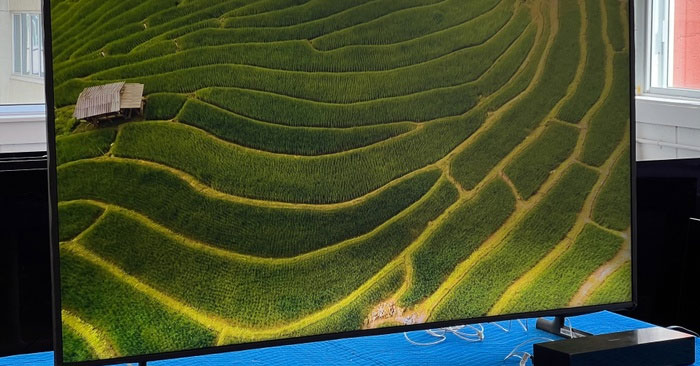Why do many TVs break after being out of warranty?
According to a 10,000-hour durability test on 100 LCD TVs from October 2022 to present by Rtings, one of the famous electronic device review sites, shows that the TV uses edge-lighting technology. lit) fails sooner than models using other backlight technology.
Edge-lit TVs, after long periods of use at maximum brightness, are susceptible to problems such as curved reflectors, cracked light guides, and burned-out LEDs. TVs with direct-lit or full-array technology are more durable due to better heat distribution.

Problem after one year of use
Not counting power supply errors, circuit board errors, burned sockets or image retention on OLED TVs, more than 25% of the 82 LCD TVs in Rtings' test had problems with uniformity of light display after a period of time. long use.
Of the 10 edge projection TVs, 7 models (equivalent to 64%) had uniform lighting problems, one was completely damaged and the remaining models showed signs of failure. With TVs using full-array backlighting or direct lighting, only 14/71 TVs have the same situation (20%).
3 out of 7 TVs that had problems displaying uniform light showed signs of degradation after only 2,200 hours, equivalent to about a year of use for a typical US household.
Design of edge projection TV
Basically, the structure of an edge-projection TV is quite simple, using LED lights arranged at the bottom edge, the back of the TV is glued light strips and a heatsink frame.
On edge-projection TVs with high LED density in small spaces, the temperature is higher than on direct-projection or full-array TVs. Therefore, the heatsink frame is a necessary part on edge projection TVs.
Specialized polymer panels, called light guide panels, are used to disperse light from the bottom across the screen. Other layers such as light diffusion film, quantum dot enhancement film, brightness enhancement film. are stacked on the LGP until light reaches the LCD panel.
Unlike edge-projection TVs, full-spectrum or direct-projection TVs only need diffusion film so that the display brightness is uniform because the backlight is spread across the surface. So no need for LGP.
LED TVs radiate a lot of heat, which will be significantly concentrated below, but on full-array or direct projection TVs because the heat is evenly distributed, this is not an issue.
The "deadly" point of side projection TV
After disassembling some TVs using side lights, experts found that the reflective panels were bent, affecting the distribution, making the light displayed unevenly. The warping spreads throughout the reflector from the bottom edge (where the LED is located) to the areas near the middle (where the power supply and motherboard are).
In addition, the TV's light guide plate was also cracked, causing light lines to be easily seen at the bottom edge of the panel, and the LED light in the TV also partially melted the light guide plate, at the bottom edge.
If you count the dense amount of LED bulbs, the heat flow density on the surface will be very large, affecting all edge-lit TVs, including expensive models because basically, the design of these TV lines is quite similar.
Why are edge-projection TVs still popular?
TV production technology using edge lighting allows manufacturers to create ultra-thin LCD TVs. Therefore, despite limitations in quality and production costs, edge projection TVs are still popular.
If you want an edge-projection TV to have a durability of 5-7 years, users should avoid leaving the TV on for too long at maximum brightness to reduce the heat stress created by the backlight, keeping the reflector and light guide intact for a long time. than.
If you are looking to buy an LCD TV and are concerned about durability, users can refer to models that use full-range backlighting or direct projection because they can avoid problems related to light guide panels.
If you buy an edge-projection TV because you like the thinness or beautiful design, you should choose models with higher brightness than necessary. When using, adjust the brightness to low to increase longevity.
You should read it
- Top 10 best tips to protect your smartphone the best
- Broken smartphone screen, if you do not want to spend money, you can refer to these cool 'fix' ways
- 7 things you should do when broken smartphone screen
- How to fix broken mosquito catch at home
- Experience in handling laptop chargers with broken wires
- How to find broken symlinks in Linux
 How to record Samsung Galaxy A12 screen without App
How to record Samsung Galaxy A12 screen without App What is Spotlight? What is taking the spotlight?
What is Spotlight? What is taking the spotlight? High quality online movie watching applications on Android and iPhone
High quality online movie watching applications on Android and iPhone Knowledge about toilet paper you may not know
Knowledge about toilet paper you may not know 7 tips to help keep technology items safe when going to the beach
7 tips to help keep technology items safe when going to the beach Time zones of countries around the world and world time zone map
Time zones of countries around the world and world time zone map